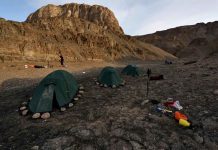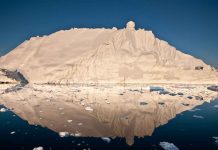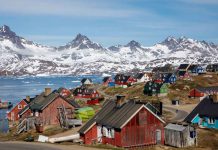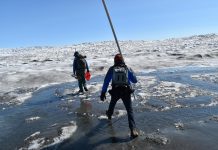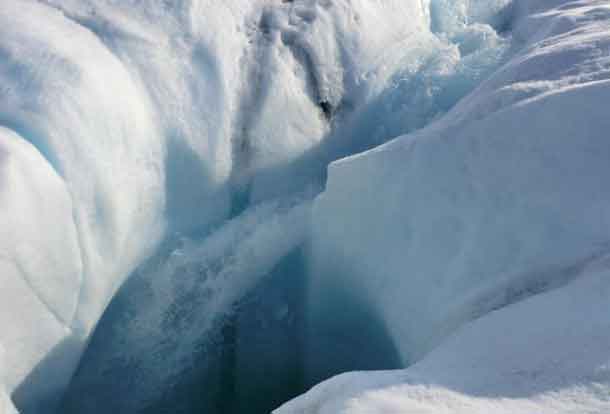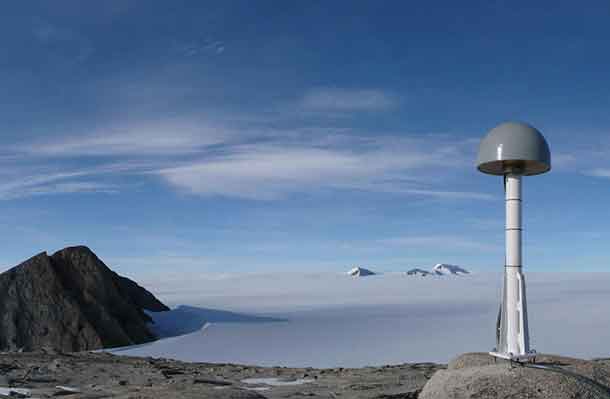

Credit: The Ohio State University and the University of Minnesota
THUNDER BAY – The Greenland Ice Sheet is shrinking. The long-term result of that ever shrinking massive sheet of ice is one of the symptoms of climate change.
Now, Ohio State University is sharing the highest-resolution satellite images ever taken of that region. And while each individual pixel represents only one moment in time, taken together they show the ice sheet as a kind of living body–flowing, crumbling and melting out to sea.
The Ohio State University has partnered with the Polar Geospatial Center at the University of Minnesota to turn images captured by DigitalGlobe’s Worldview-1 and 2 satellites into publicly available elevation maps that researchers can use to track the ice.
Ian Howat, associate professor of earth sciences at Ohio State, presented the project’s first data release in a poster session at the American Geophysical Union (AGU) meeting on Dec. 18, 2014.*
He called researchers’ access to DigitalGlobe’s imagery “one of the biggest breakthroughs for earth science satellite capabilities in decades,” adding that “it’s only been a few years since we’ve gotten access to really high-resolution imagery from government agencies, and we’re already discovering new things about the ice sheet.”
Greenland Ice Depth – NASA
The imagery starts out at a resolution of about 0.5 meters. The researchers then turn it into digital elevation maps with a resolution of 2 meters.
With hundreds of terabytes of polar data already collected and additional surface area equivalent to the state of Missouri being collected every day, the researchers are steadily processing it all with new Ohio State software called SETSM (for Surface Extraction from TIN-based Search Minimization). Ohio State research associate Myoung-Jong Noh created the software, which builds 1-gigabyte “tiles” representing regions 7 kilometers on a side and assembles them into mosaics depicting land, sea and ice elevation.
Each tile is extracted from a pair of images acquired of the same region, but about 45 seconds apart. SETSM combines the two displaced images into a coherent whole, as our brain does when it combines images from our two eyes. SETSM uses the Worldview satellites’ sensitivity to a very wide band of the electromagnetic spectrum to show things that our eyes alone couldn’t see, including tiny changes in elevation.
As an example, Howat pointed to the portion of the mosaic showing Jakobshavn Glacier, the fastest-flowing glacier in the Greenland Ice Sheet. Icebergs that have calved off the edge of the glacier are visible floating out to sea–but so are cracks hundreds of kilometers inland from Jakobshavn, on what would otherwise be a flat expanse of ice.
The winding, parallel cracks, which resemble ridges on a fingerprint, are signs that the ice is accelerating, Howat explained. As the ice flows faster and approaches the sea, the surface gets stretched out and cracks open. Over time, the cracks widen. The situation is similar to cars on a highway, he explained: Cars may be bunched up when they first enter the highway from an on-ramp, but they gradually spread apart as they accelerate to highway speeds.
Any research that relies on measuring changes in the Earth’s surface, including studies of volcanoes and coastal erosion, would benefit from elevation data produced by the SETSM software, Howat said. Applications for SETSM outside of earth science include computer vision, astronomy and national security–any job for which very large amounts of terrain are mapped at high resolution.

